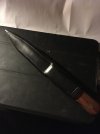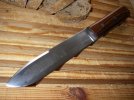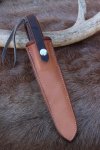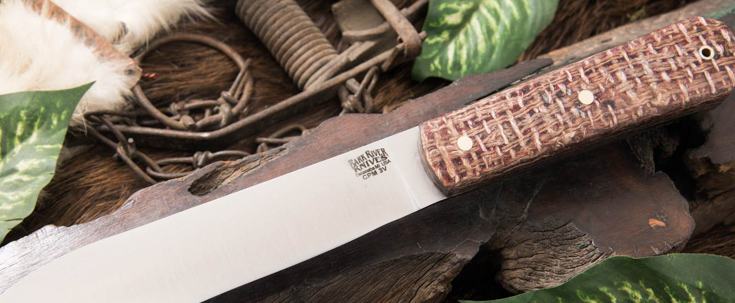Henry Beige
Gold Member
- Joined
- Jun 1, 2015
- Messages
- 3,718
A couple of times in recent months I have come across mentions of the Russell Green River Dadley knife, thought to be a precursor to Horace Kephart’s design. Scrteened Porch was the most recent to bring it up. His posts prompted me to go looking for one last week.
In placing the order, somehow signals got crossed, and what I got was not quite what I expected. Instead of a Russell Green River knife, with its familiar coarsely checkered beechwood handle, what arrived was the knife below. The etch on the blade reads
Sheffield
L Adams Ltd
England.
No mention of Dexter Russell or Green River. Nevertheless, it was a pleasant surprise.
The handle is smooth hardwood with a glossy finish; no need to sand to avoid splinters or hotspots. The knife is decidedly right-handed: the swedge and the scallops on the spine appear only on the display side of the plade. The off side is flat and blank. The handle has finger grooves only on one side, for a right hander.
The knife came with a pretty nice leather sheath, not mentioned in the sale listing. The belt loop is unusable, but I would never wear it on my belt anyway. The fit is nice and close, so a guy could easily drop the knife into a pocket, or carry it in a pack.
I promptly made an order for the correct Russell knife, but I’m going to keep this one, too.
So here’s the question: what’s the deal with the scallops on the spine? I will see if I can track down an answer, but if anybody knows, or even has a theory, I would be grateful to hear it.
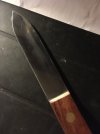
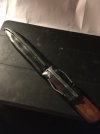

In placing the order, somehow signals got crossed, and what I got was not quite what I expected. Instead of a Russell Green River knife, with its familiar coarsely checkered beechwood handle, what arrived was the knife below. The etch on the blade reads
Sheffield
L Adams Ltd
England.
No mention of Dexter Russell or Green River. Nevertheless, it was a pleasant surprise.
The handle is smooth hardwood with a glossy finish; no need to sand to avoid splinters or hotspots. The knife is decidedly right-handed: the swedge and the scallops on the spine appear only on the display side of the plade. The off side is flat and blank. The handle has finger grooves only on one side, for a right hander.
The knife came with a pretty nice leather sheath, not mentioned in the sale listing. The belt loop is unusable, but I would never wear it on my belt anyway. The fit is nice and close, so a guy could easily drop the knife into a pocket, or carry it in a pack.
I promptly made an order for the correct Russell knife, but I’m going to keep this one, too.
So here’s the question: what’s the deal with the scallops on the spine? I will see if I can track down an answer, but if anybody knows, or even has a theory, I would be grateful to hear it.




